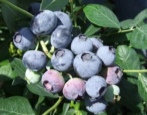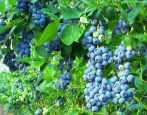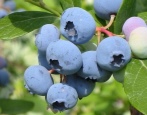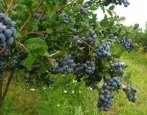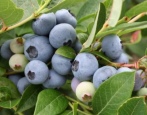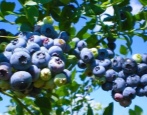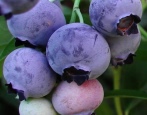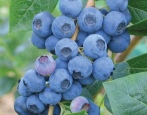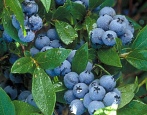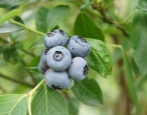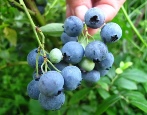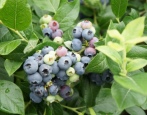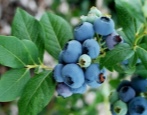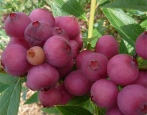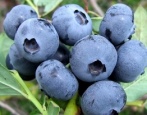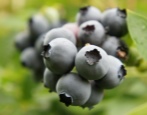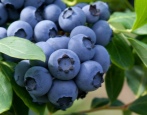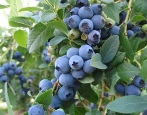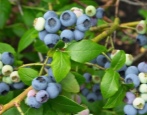
- Authors: North America
- Ripening terms: mid-late
- Growth type: tall
- Bush height, m: 1,6-1,8
- Taste: very sweet with a grape aftertaste
- Yield: high
- Average yield: 4-6 kg per bush
- Fruit size: large
- Fruit color: blue
- Description of the bush: upright, with a dense crown
The blueberry plant has recently become popular with gardeners. Before that, the culture was considered exotic. Particularly popular with blueberries in regions where summers are short and cool, and winters are characterized by harsh conditions. The Elizabeth variety is one of the most demanded, because it is frost-resistant, late-ripening, giving a tasty berry harvest.
Breeding history
Varietal blueberries are native to North America, and until the 19th century, the fruits were harvested wild. Plants were cultivated only in 1906. A pioneer in this direction was a botanist named Frederick Vernon Covill. The hybrid is known as the cross between Jersey and Catharine.
Description of the variety
The spreading bush grows from 1.6-1.8 meters. Shoots are erect, with a characteristic red color and green leaves with a bluish bloom. They intertwine, forming a dense crown. The redness of the cover of the shoots indicates the high frost resistance of the plant. Flowers on the bush bloom in spring and delight the eye with a delicate white-pink color.
With regular grooming of the Elizabeth blueberry bush, you can harvest for half a century. The regions where it is recommended to grow berries are in the middle zone of Russia.
Fruit characteristics
The fruits are large in size, reaching a diameter of 20-22 mm. The color of the blueberry peel is a traditional blue color with a characteristic bloom. It is dense and not prone to cracking. The brushes are loose, they can be easily removed from the branches.
Taste qualities
Blueberries taste very sweet, with a subtle grape aftertaste. This dessert variety is one of the most delicious in the world.
Ripening and fruiting
The first harvest of berries can be obtained in the 5-6th year from planting. For the first couple of years, the plant is not supposed to bear fruit in order to form a strong bush.
The fruiting period is the first days of August, with an annual frequency. The first berries ripen in early August, fruiting lasts several weeks. In terms of the volume of the crop harvested from the bush, it can be noted that spring return frosts directly affect it.
Yield
The average blueberry yield is 4-6 kg per bush. This is considered a high rate.
Self-fertility and the need for pollinators
Elizabeth belongs to the self-pollinating varieties. But in order to make the blueberries juicier and larger, it is worth planting blueberry varieties with the same flowering period nearby. Most often, Bluecrop, Darrow, or Nelson, Jersey varieties are planted.
Growing and care
In order for the plant to grow strong, and the harvest to be richer, in addition to weather conditions and compliance with all agricultural techniques, it is important to choose the right planting material and observe the planting time.
Usually, seedlings of this culture are supplied with closed roots. It is important that the soil in the container is not dry.
And also blueberries are propagated by seed and seeds are sown in August. The soil is pre-acidified with peat. The seeds are deepened into the soil by about 1 cm, sprinkling with sand mixed with peat. The box is covered with a layer of foil.
Watering is carried out by the irrigation method. The sprouts are transplanted in separate containers as soon as a couple of leaves appear on them. Move to open ground a year later from planting.
The main disadvantage of this breeding method is the low fruiting rate. The first harvest is not to be enjoyed soon, but only seven years later.
Vegetative ways
Usually a bush propagated in this way pleases with blueberries already in the 4th year. This is more promising and beneficial for gardeners.
It is more convenient and simple to propagate by cuttings. Planting is carried out in light soil mixed with peat. In open ground, seedlings are moved in the second year.
Cutting is also a popular breeding method for edible and decorative blueberry varieties. The selected shoots are bent to the ground, fixed with garden hairpins and sprinkled with earth. Several years will pass, and the shoots will take root, then the layers are supposed to be separated from the mother plant and transplanted.
By dividing the bush, the fruit crop is transplanted less often. In this case, the bush is dug up, and the root system is divided so as to preserve at least 7 cm of rhizomes in each part. Cutting points must be processed with crushed coal, and new bushes must be planted.
Pits for seedlings are prepared in advance: 0.6 m is considered to be sufficient depth, 0.1 m in diameter are adhered to, observing a step of 2 m.
Elizabeth's blueberry planting algorithm is clear and simple.
Drainage is distributed along the bottom of the pit using crushed stone or gravel.
A seedling with an earthen clod is immersed in a hole.
The root collar is deepened by 5 cm, all roots are straightened.
The substrate is poured on top and compacted.
The near-trunk area is laid out with a layer of sawdust at least 5 cm thick.
After planting the seedlings for a couple of seasons, you need to pick off all the buds that appear to allow this berry bush to get stronger and grow enough.
For Elizabeth to ripen, abundant watering is necessary, especially in dry times. Irrigation is shown to be carried out at least twice a week, preventing stagnation of water, as well as controlling the level of humidity. Cracking of the soil must not be allowed. When watering one bush, you need to use a couple of buckets of water: one - early in the morning, the second - later than 7 pm.
The plant is also important to feed. Effectively fertilize Elizabeth blueberries with ammonia to acidify the soil. Nitrogen-containing dressings are applied only in spring and early June. During the ripening period of the crop, it is required to fertilize with any dressings containing potassium salts.
Sanitary pruning with crown thinning is carried out annually. The procedure is carried out with the arrival of spring or in winter, when the bush is dormant. The first pruning is done only 5–6 years after planting.
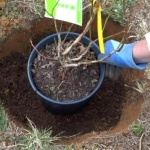
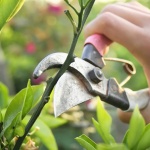
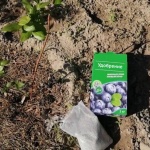
Disease and pest resistance
This variety is distinguished by good resistance to parasites and various fungal infections such as late blight, root rot and others.
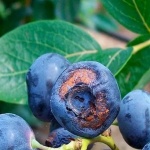
Winter hardiness and the need for shelter
The winter-hardy variety can withstand frosts up to -32 degrees without shelter. The flower buds on Elizabeth's blueberry bushes do not freeze out in the winter season, but they receive insignificant damage when the return frost occurs.
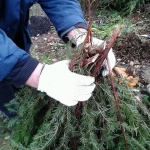
Location and soil requirements
Blueberries grow poorly on sandstones, but very well accept soils with a moderate peat content. Horticultural crops are planted in sunny areas protected from the wind.
It is important to remember that heavy and waterlogged soils are not suitable for the plant, so the bushes are planted on a hill. Thus, both the surrounding trees and taller shrubs do not cast a shadow on the short plant.
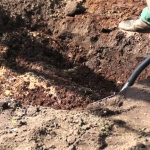

Review overview
The Elizabeth variety is suitable for mechanized harvesting. The harvested crop can be transported over long distances without damage, but it is not stored for long. In just a few days, it starts to deteriorate.
Ripe multi-purpose blueberries have excellent taste. The taste is reminiscent of grapes, and someone can feel the flavor of blueberries.
Some gardeners note that in the cold early autumn, the berries do not always have time to ripen. In addition, blueberries are praised for their excellent taste and are used for consumption fresh for food and for growing on an industrial scale. Elizabeth berries are suitable for making savory gravies, sweet tea preparations.
